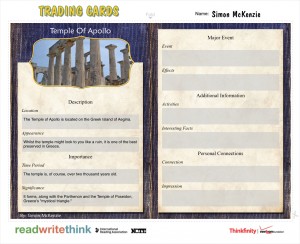(#Bloggermore2015 2/26)
To Australian readers … I hope you are enjoying our national holiday; even though, in most parts of the nation, tomorrow will see students returning to school for the first day of the new school year. I thought this might be an opportune time to share five of my favourite iPad apps; apps that will have a big role to play in my year. One is new (at least to me) while the rest are returning for another year of great service.
1. ThingLink continues to introduce new features at regular intervals. The ability to take an image or video and add a variety of links (such as further images, information, video or questions) has countless possibilities in the classroom. I have found ThingLink particularly useful for teaching visual literacy and interpretation in Senior History. If you’ve never seen a ThingLink, this link will take you to one of mine
https://www.thinglink.com/scene/311319169452736514
2. Socrative provides teachers with the opportunity to quickly create quizzes or polls. Students can easily respond either from the companion app or from any Web browser. Socrative will even email you the results with valuable analysis. Great too for exit tickets and for younger students there’s the Space Race game … which I’ve been known to play with very enthusiastic Year 12s!
3. Trading Cards quickly became one of my favourites. As the name would imply, teachers and students can make trading cards for a range of uses. The cards are especially useful for student revision but are also a novel way to deliver otherwise “dry” content. A great app from ReadWriteThink; the partially completed example below shows you the possibilities …
4. Weebly will undoubtedly be familiar to many of you and it continues to be my “go to” app for building websites. You will also find that students quickly adapt to the WYSIWYG (What You See Is What You Get) design method. Once published, the site can be accessed from any device. The available features in Weebly are too numerous to list here but the link below will take you to one of my sites as an example. (*You should consider, as I have done, buying a PRO subscription for even more features.)
http://elsinoreinashmore.weebly.com
5. Workflow is the new kid on my block. I’m certainly not an experienced user of this app but I’m excited about the possibilities for time impoverished teachers. Workflow allows you to “connect apps and actions together to automate things you do on your device. To build a workflow, just drag and drop.” You can add any workflow to your home screen as an “app” and then launch it with a tap. Check it out; I’m sure you’ll be as impressed and excited (or is that relieved?) as I am.
Well, that’s it for #Bloggermore2015 2/26 … I’ll be back within two weeks for another exciting instalment.

